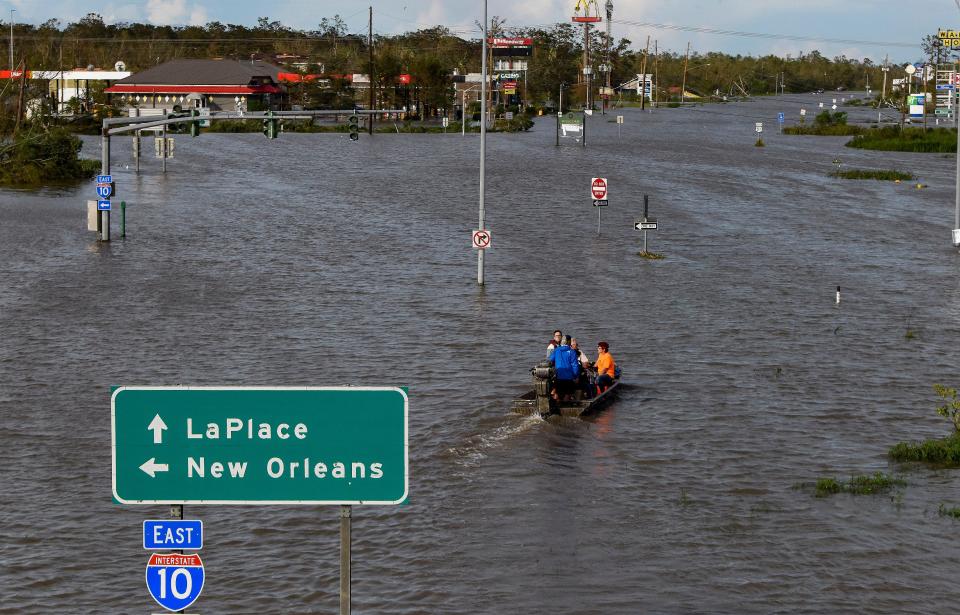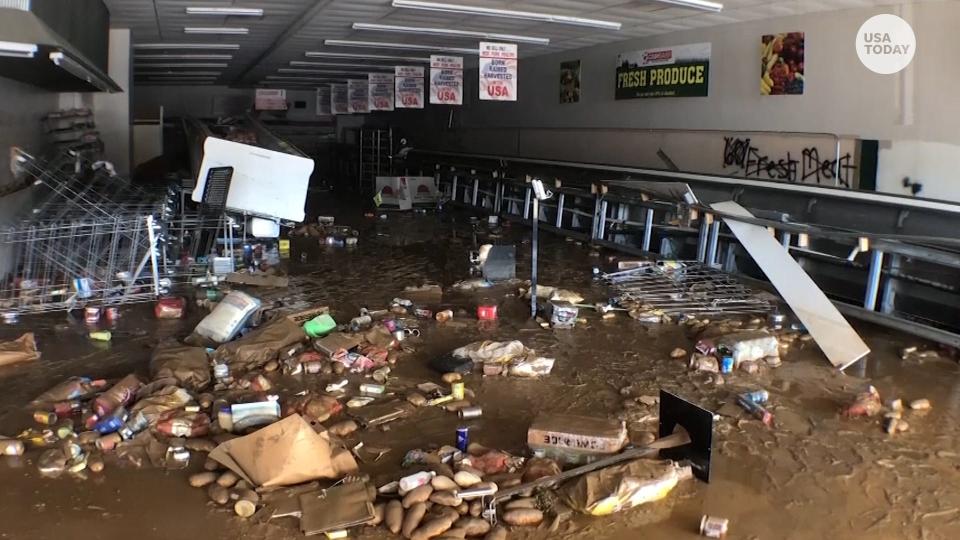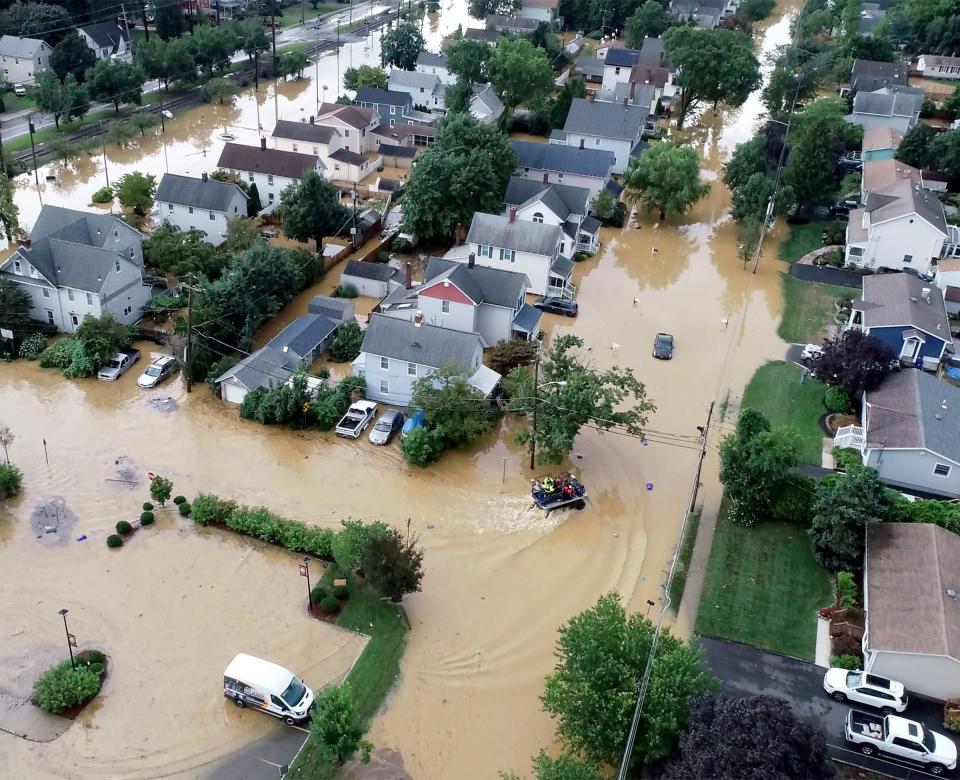Hurricane Ida is the latest example of extreme weather events driven by climate change
- Oops!Something went wrong.Please try again later.
Nicholas Bassill watched in horrified fascination Wednesday night as data from a network of rain gauges across metropolitan New York showed skyrocketing rainfall from the remnants of Hurricane Ida as it blew through the Northeast.
The lower Hudson Valley, much of Long Island, parts of New Jersey and Connecticut and the entirety of New York City saw extreme rainfall totals.
It was unlike anything Bassill, the director of research and development for a Center of Excellence at the University at Albany, had seen in the decade since those gauges were installed.
“You might expect one place to get some wild, absurd rainfall total or rainfall rates,” said Bassill, but not the entire metro area at once.
Ida, which struck Louisiana with 150 mph winds and more than a foot of rain, deluged every state in its path as it swept northeast, killing more than 60 people. But the storm is just the latest in a series of extreme weather events across the country.
Record snow storms and freezing temperatures paralyzed Texas in February. Wildfires have ravaged nearly 5 million acres in the West this year. Extreme heat and drought scorched the Southwest and Northwest throughout the summer. Deadly flooding inundated cities in Michigan and Tennessee in June.
Last year the U.S. logged 22 billion-dollar disasters, the most in history, according to the National Oceanographic and Atmospheric Administration. This year, there have been eight through June.
Sixty-nine all-time precipitation records have been set across the country this year, along with 422 records for all-time maximum temperature.
No single event, like Ida, proves that climate change is causing more rainfall. That would take months or years of study, Bassill said. “But if you were trying to prove it, these are the events you would use.”

Snowstorms, heat waves, wildfires and hurricanes have happened in the past, but warming temperatures is making natural disasters worse, more than a dozen climate scientists told USA TODAY in recent weeks. The heat supersizes the effects of these storms, they said.
More intense rainfall in thunderstorms, tropical cyclones and other events is one of the most solid predictions as the atmosphere heats up, said Kerry Emanuel, a climate scientist and professor at the Massachusetts Institute of Technology.
That’s because the air holds 7% more moisture for every 1.8 degree increase in temperature. If the air warms by 2.5 degrees, that’s a 12% increase in water vapor.
That may not sound like a lot, but many of the nation’s flood control measures “were designed for the climate of the past,” he said. “You don’t have to exceed that by very much before these structures begin to fail.”
To see it all happening “is a bit humbling to tell you the truth,” Emanuel said Thursday. “In some cases, these increases are larger than we expected to see, and it makes us wonder if we’ve done our homework.”
Hurricane Ida
Stella Lavine swept muddy water from a sidewalk in front of her Philadelphia apartment on Thursday and looked around at the flood damage caused by remnants of Ida’s intense rainfall.
A historic canal in front of her home topped its banks after 9 inches of rain Wednesday night, sending water toward her apartment and into the next building over and prompting evacuations.
Ida formed in the Caribbean five days before making landfall on the Gulf Coast. As it moved over the warmer than normal Gulf of Mexico, the storm intensified, taking advantage of a pocket of high heat, said Peter Jacobs, a climate scientist and communications specialist at NASA’s Goddard Space Flight Institute.
“Ocean heat in general has been dialed up because we’ve warmed the climate, and the air is holding more moisture because we’ve warmed the climate, and sea levels are higher because we’ve warmed the climate,” Jacobs said. “And all those things are sort of amplifying natural features of the storm.”
After dropping more than 16 inches of rain in some locations to the west of New Orleans, Ida soaked parts of Mississippi, Alabama and Tennessee.
In the Northeast, the National Weather Service in Mount Holly, New Jersey, reported more than 275 gauges in its region received more than 5 inches of rain, including 11 inches in Flemington, New Jersey.
In Newark, 6.4 inches exceeded what’s considered a 1 in 1,000 year rain event. A final total of 8.41 inches broke the city’s all-time rainfall record, set at 6.73 inches on Nov. 8, 1977. The 6.8 inches at LaGuardia Airport in Queens, New York, broke another all-time record.
In Philadelphia, where Lavine lives, one gauge in the city logged 9.36 inches of rain.
Lavine said she learned in previous floods that the trick is to sweep the wet mud away before it cakes and dries. As the waters rose on her street during the storm Wednesday, she said, she watched as they stopped a foot short of her door, then began to recede.
She’s among many who believe the extreme weather events are more than just a coincidence.
“There is something going on,” she said.
Elsewhere across the U.S.
Similar rainfall extremes have been seen in other weather events this year alone.
A new all-time 24-hour rainfall record was set in Tennessee in August when a storm dropped 17.06 inches of rain in Mcewen. More than 9 inches of that fell in just three hours – a rate of more than 4.25 inches an hour at one point.
The flooding prompted dramatic rescues but left 22 dead.
Detroit has seen flooding at least three times this summer. In June, more than 6 inches of rain fell on a Friday night, overwhelming the city’s stormwater system. It was the third historic flood event in just eight years, said Rich Pollman, warning coordination meteorologist for the National Weather Service in Detroit.

Among other extreme events this year was a system that plunged Texas into record-cold temperatures for more than a week, and brought several rounds of snowfall, including 7.5 inches in Austin. The event triggered a statewide collapse of the power grid and caused the deaths of 210 people.
In March, a tornado outbreak sent 43 twisters ripping across 11 Southern states. Scientists report tornadoes are forming earlier and later in the year and are occurring more often in some states.
In May, Tropical Storm Ana marked the seventh year in a row a named storm formed before the traditional June 1 start of the Atlantic hurricane season.
After Claudette, the season’s third named storm, blew through Tuscaloosa, Alabama, in June and dropped up to 8 inches of rain in Northport, Kimberly Madison stood with tears in her eyes as a crew helped clean out her flooded home.
“We used to get intense rainfall once in a while, but now it happens really often,” Madison said. And it happens really often in Alabama.”
The opposite problem has plagued the American West this summer. All-time maximum high temperature records fell in California, Arizona, New Mexico, Utah, Colorado, Wyoming and Montana in June. In Phoenix, high temperatures were over 115 degrees for a record-setting six consecutive days, with a high of 118 on June 17.
The extreme high temperatures combined to make June the warmest on record in the contiguous United States.
In California, where wildfires have burned more than 579,614 acres this summer and damaged or destroyed 400 structures, the fires have done something no fire has ever done in history. The Los Angeles Times reported this week that Chief Thom Porter of the California Department of Forestry and Fire Protection said fires had burned across the Sierra Nevada for the first time.
Global trend apparent
The U.S. isn’t alone in climate extremes. Hong Kong saw its warmest May on record. New Zealand saw its warmest June since records began in 1909.
Globally, July saw its highest temperature since records began 142 years ago, according to the National Oceanic and Atmospheric Administration.
In Europe, catastrophic flash flooding in July killed more than 230 in Germany and Belgium. German broadcasting company Deutsche Welle reported that Carl-Friedrich Schleussner, a research leader at Humboldt University in Berlin, said the question wasn’t whether climate change had contributed, but “how much.”
An international group called World Weather Attribution studies individual severe weather events around the globe to determine whether they can be attributed to the changing climate.
This year, the group reported the extreme heat over western North America this summer was “virtually impossible" without human-caused climate change. The group detected the fingerprint of climate change in Hurricane Harvey, which flooded Texas in 2017, and in a 30-inch deluge in Louisiana in August 2016.
The group said it had high confidence that human-induced climate change has increased the likelihood and intensity of the severe flooding events in Europe this summer.
Humans are to blame
A recently released report from the U.N. Intergovernmental Panel on Climate Change came to similar conclusions after its authors reviewed hundreds of papers by scientists documenting the effect of the warming climate around the world.
Jessica Tierney, a paleoclimatologist and associate professor at the University of Arizona, helped write a chapter of the report. She said the biggest change in the document compared with previous versions is the “increased confidence that humans are responsible for some of the extreme events we’ve seen.”
She sees two reasons for that: the science of attribution has improved, and climate change has gotten worse. Its consequences are harder to miss.
The report found more robust evidence or a high likelihood for many of the disasters seen around the world this year. The group concluded that extreme precipitation has “very likely” increased in Europe and North America since the 1950s and that the heavier rainfall, combined with sea level rise, has increased the probability of compound flooding from storm surge and higher river flows.
When the report was released, Katherine Hayhoe, chief climate scientist for The Nature Conservancy, said events of the past year have proven climate change is happening in real time.
“From record-breaking heatwaves and severe droughts, to catastrophic wildfires and devastating floods, climate-driven threats are increasingly part of our daily headlines,” she said.
For residents of Philadelphia and New Jersey and millions of others this week, the headlines are all too real.
The weather service office in Mount Holly set a record in 2020 for the most tornado warnings in a year with 36. On Wednesday, it issued 16.
After a day of field surveys, the office's forecasters confirmed seven tornadoes in the region, including one EF 3, with 150 mph winds, that injured two people in Mullica Hill, New Jersey. The station had recorded only four other tornadoes of that magnitude in history.

A few yards away from Lavine’s northwest Philadelphia home, Robert Olszewski looked over his Manayunk neighborhood, a hilly enclave with slopes that tilt toward the old canal and the Schuylkill River where he has lived all his 61 years.
At the bottom of the hill, several restaurants and businesses were inundated Wednesday night as the Schuylkill crested to a record 26.5 feet at Norristown.
Asked where the storm ranked on a long list for flood-prone Manayunk, there was no hesitation.
“Top,” Olszewski said. “It never got this high.”
This article originally appeared on USA TODAY: Hurricane Ida latest example of extreme weather due to climate change

